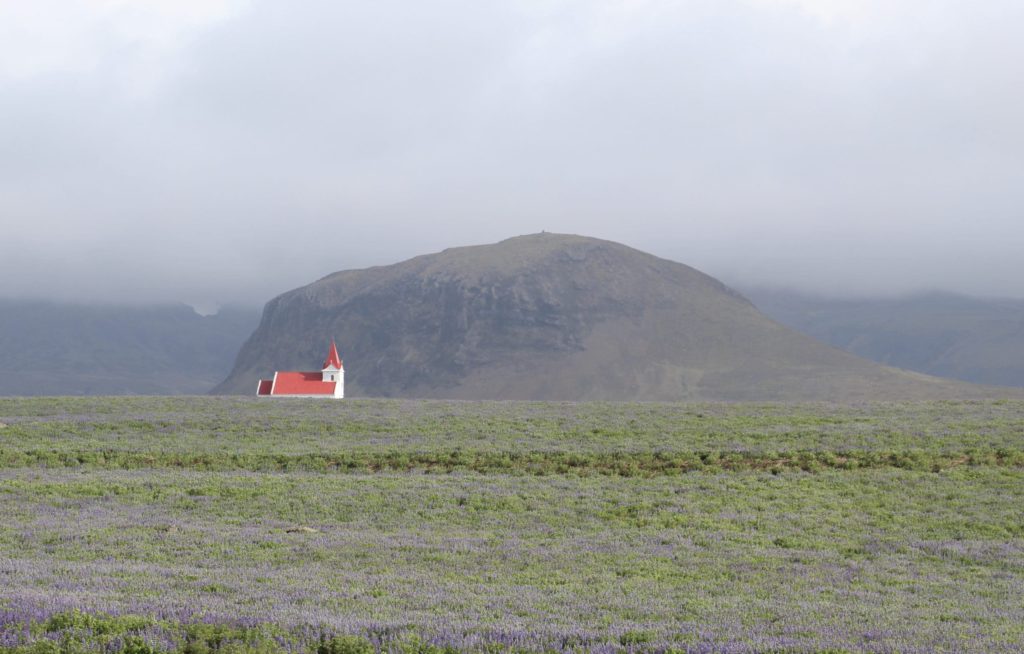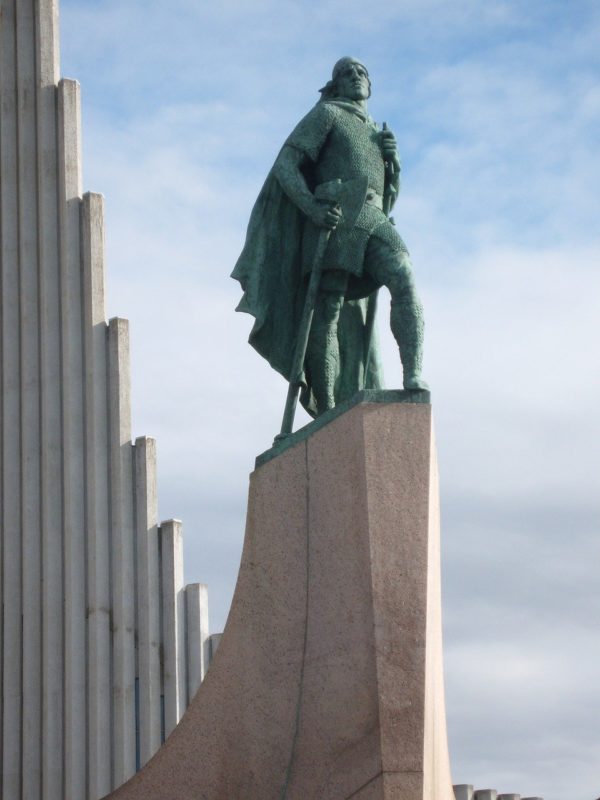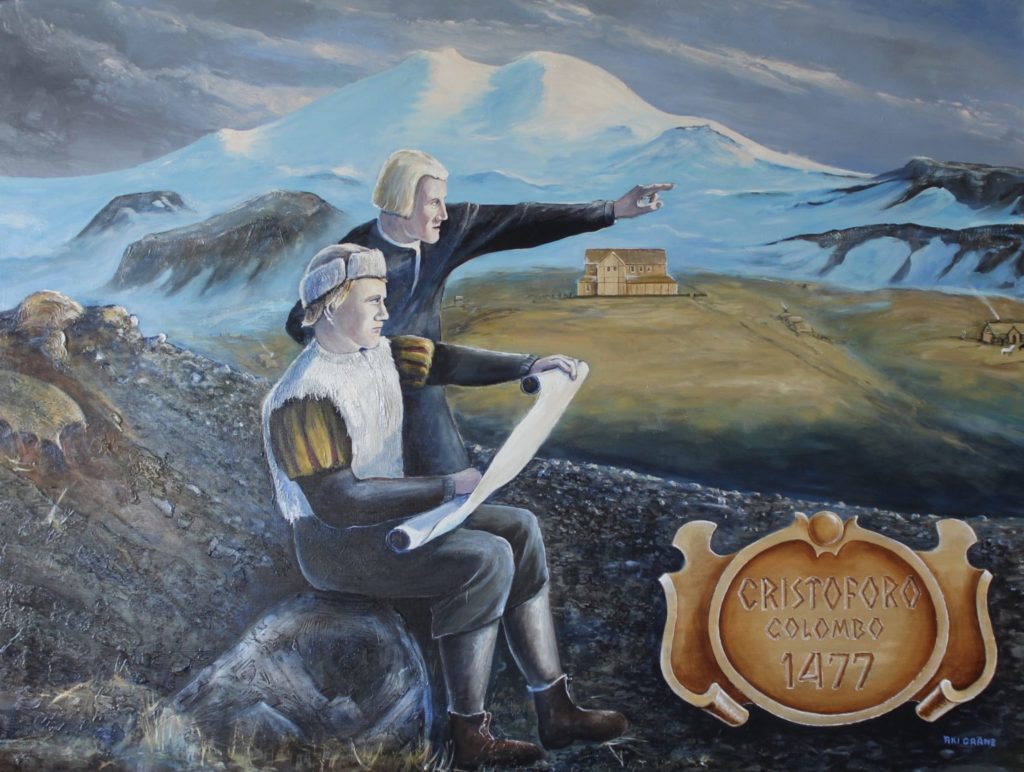No products in the cart.

The late evening Icelandic sunset brightly illuminates the church at Ingjaldsholl.
PHOTO: KIRK JOHNSON.
Although most are unaware, Christopher Columbus’s discovery of the New World—and thus the nascent beginnings of the United States—likely had origins in western Iceland. Yes, Iceland. Specifically, the region of western Iceland including the Snaefellsnes Peninsula, and associated Breida Fjord, from which the legendary Viking explorer Leif Eriksson hailed more than 1,000 years ago.
Like many Americans with Scandinavian ancestry, I am proud of our peoples’ long, rich and storied history. My Scandinavian roots are primarily Swedish, and so I travelled to Sweden several years ago to explore places my ancestors lived. But I am also intrigued by the history of Iceland, which was settled by Scandinavians during the late 800s and early 900s.
During a June 2021 Iceland vacation, I wanted specifically to investigate the little-discussed possibility that the great Christopher Columbus himself had also visited, over the winter of 1477 to 1478 at a farm and church called Ingjaldsholl, and while there learned from the native ethnic erstwhile Viking people about their frequent exploits in Vinland (North America) just a few centuries earlier.
This would help explain much about Columbus’s own journey to America fifteen years later, and why he was confident that he would find land “across the ocean blue.” Too few realize that Columbus himself chronicled this Icelandic visit in his journals, and also highlighted it in a 1495 letter he wrote to King Ferdinand and Queen Isabella of Spain.

In 1000 AD, Leif Eriksson’s party landed and established a short-lived settlement at what we today call L’Anse aux Meadows, Newfoundland, Canada. For centuries afterward, while their small civilization at the south end of Greenland persisted, Vikings returned repeatedly to the east coast of North America in order to gather timber, game, grapes and berries, and to trade with the ‘Skraelings,’ who we know today as American Indians.
Upon my arrival in Iceland I told the office manager at Happy Campers in Keflavik (where I rented a small camper van) the reason for my interest in visiting Ingjaldsholl. He emphatically responded that “it must be true” Columbus stayed at Ingjaldsholl. We had been poring over a large table-top map of the country in the Happy Campers’ lobby when the subject came up.
The next day I went to the National Museum of Iceland in the capital city of Reykjavik, a forty-five minute drive from Keflavik. It was a quite rainy day, so I made the most of it by visiting a number of different museums. The National Museum of Iceland guides visitors chronologically through the history of the country, from settlement in the 800s to the present.
Finding, as expected, no mention of Columbus in the 1400s portion of the museum, I inquired with museum staff. They did know of the Columbus story, but explained that since it is not universally accepted by all historians, the museum does not make reference to it. Some do not believe that there is sufficient extant documentation to establish that Columbus visited, and are loathe to take his word for it that he did. And in any event, there are no known artifacts from Columbus’s visit available to display. However, I was informed, if you go to the little towns near where he is said to have overwintered and ask anyone on the street, they will happily tell you that it is true.
Two days later, I went to Ingjaldsholl late on my first evening on the Snaefellsnes Peninsula, but not surprisingly the church there was closed. I walked around it and peered into the windows at the pristine, intimate sanctuary, and took some nice photos of the church in the setting sunlight. I was even able to capture a reasonable picture through the window in the parish office down below of a painting of Columbus on the wall in a large meeting room.
The next morning I visited the tourist information center in nearby Olafsvik. The agent there was a friendly, knowledgeable, and helpful woman, and she knew the man who was the minister at both Ingjaldsholl and the church in Olafsvik. She kindly arranged for me to meet with the minister at Ingjaldsholl. He was willing to give me a personal tour and answer my questions. I almost could not believe my luck!
The knowledgeable Oskar Ingi Ingason has been the minister at Ingjaldsholl since 2012. The current church was consecrated in 1903 and is the world’s oldest entirely concrete church. Reverend Ingason is also the minister at the modern church in Olafsvik, which was consecrated in 1967. He was on the board of directors for the organization that helped design and reconstruct the Leif Eriksson birthplace, living museum, and historical site to the east. Established in 2000, the site is called Eiriksstadir, meaning “Erik’s place,” named after Leif’s father Erik Thorvaldsson (Erik the Red).
Reverend Ingason told me about the well-known oral tradition around the Olafsvik-Rif-Hellissandur maritime region that Columbus visited Iceland and stayed at the farm at Ingjaldsholl during the winter of 1477 to 1478, likely arriving sometime in the early autumn and leaving in late spring. It is known that a “southern gentleman” stayed there that winter (with “southern” denoting someone from the south of Europe). According to Columbus’s own diaries, and Ferdinand Columbus’s 1571 biography of his father, he indeed stayed at Ingjaldsholl.

Columbus’s ship docked at nearby Rif. He came to this area of Iceland specifically because he would have known that Leif Eriksson came from the Breida Fjord region. Columbus was aware of Eriksson’s voyages and wanted to gain information about Viking exploration in preparation for his own journey west—he was visiting quite deliberately in order to ‘do his homework.’ Reverend Ingason told me Columbus stayed at Ingjaldsholl because the nearby Hellissandur was actually the largest town in the area at the time, as a result of their substantial fishing industry.
Early last year, a parishioner informed Reverend Ingason that he had become aware of a large timber which was purported to have been part of Columbus’s ship and had been incorporated into the construction of an old house in the northern part of Iceland. The timber was said to have been at the farm at Ingjaldsholl until the 1800s. When the last inhabitants of Ingjaldsholl left, they removed the timber to their new place in northern Iceland.
Large wooden timbers would have been highly valued construction material in Iceland—and difficult to come by due to it being a largely treeless land. There were some thick lowland forests when the Vikings first arrived, but they were composed primarily of relatively small, crooked downy birch trees generally not suitable for manufacturing large timbers, and even those forests had been all but denuded within a few centuries.
After touring the charming, meticulously maintained church sanctuary, Reverend Ingason and I walked down through an underground corridor into the newer parish office section, where I was able to view the “Cristoforo Colombo 1477” painting by Icelandic artist Aki Granz first-hand. Gifted to the church by the artist in 1998, the painting depicts Ingjaldsholl’s priest at the time (not unlikely Bodvar Jonsson, known to have been there in 1480 and possibly as early as 1476) symbolically pointing Columbus toward America.

In recent years, some have worked hard at portraying Columbus as a controversial figure in America. The intellectually dishonest wont from some contemporary historical revisionists is to willfully mischaracterize Columbus as a bumbling fool who did not know what he was doing as he made his way blindly across the Atlantic in 1492, being lucky to find any land at all. And sundry other such absurd calumnies — any false narrative to as an end in itself sully the reputation and cast aspersions upon the historical luminary they hold in such contempt.
That Columbus purposefully travelled to Ingjaldsholl and learned from the Icelanders in the lead-up to his New World trip helps demonstrate that this is not the case. My great Scandinavian ancestors, who were such brave, noble and accomplished world explorers, were able to provide Columbus with knowledge and confidence from which he surely benefitted in order to help him make a more informed attempt at finding a way across the Atlantic.
“Leif landed first,” as the old saying goes, because he and the Vikings were indeed the first Europeans to arrive in the Americas. But it took a skilled navigator in Columbus, half a millennium later, standing on the shoulders of what the Vikings had already experienced and learned, to help Europeans finally gain a permanent foothold in the New World. Columbus’s trip should not be thought of as being independent of or unrelated to Leif Eriksson’s deeds, but rather a logical progression and an expansion upon them.
As an ethnic Scandinavian, I am proud of what Eriksson and the Vikings accomplished in discovering the New World. At the same time, as a red-blooded American, I am naturally also quite grateful to Columbus for being wise enough to recognize the Vikings’ proficiency, prudent enough to deliberately seek out their knowledge, and courageous enough to build upon what they had already accomplished. Thanks in no small part to Eriksson and Columbus, Americans like me now live in a truly amazing place built by centuries of men and women, not just in the New World, but in Europe.
Over the years there have been unfortunate disagreements between Scandinavian-Americans and Italian-Americans over who deserves primary credit for the discovery of America, but it is past time to leave such contentiousness behind. Let us simply agree that both Eriksson and Columbus were irreplaceable in extending Western civilization to include the New World.
What is needed are more monuments across America and Europe, not just to Christopher Columbus or Leif Eriksson, but rather that symbolically portray the two profoundly consequential trailblazers together, shaking hands in the good cooperation that they for all intents and purposes engaged in across the centuries in helping to assemble the beginnings of America. If they only knew at the time the enduring gravity and magnanimity of what they were accomplishing for mankind.